

⾝体への負担の少ない「低侵襲医療」を柱として、前⽴腺疾患の診断から治療までの
すべてをお引き受けするのが「前⽴腺治療センター」の役割です。

安全性、確実性の高い⼿術を可能にする⼿術⽀援ロボット「ダビンチXi、SP」を⽤いた腹腔(ふくくう)鏡下/後腹膜鏡下⼿術、病巣にピンポイント照射できるロボット型放射線装置「サイバーナイフ」を⽤いた放射線治療、体内に小さな放射線源を埋め込んで放射線治療を行う「密封⼩線源治療」、ロボットで制御しウォータージェットで前立腺を切除する「アクアビームロボットシステム」を4本柱としております。これらの先端医療を導⼊することにより、合併症などがあり⼿術に不安をお持ちの患者さんやご⾼齢の患者さんなどにも治療の選択肢が⼤きく広がり、患者さん⼀⼈ひとりに合わせたオーダーメードな治療を提供することが可能となっています。
- 低侵襲医療
- 「侵襲」とは、医療⾏為などで「⾝体を傷つけること」を広く意味する医学⽤語です。とくに⼿術は、切開により⾝体に⼤きな傷ができてしまうことや臓器の⼀部がなくなることなど、患者さんにとっては⼤きな「侵襲」を伴うものといえます。しかし、医療技術の進歩に伴い、近年では病気を治すことはもちろん、⾝体への負担をできるだけ軽減する「低侵襲医療」が可能になりました。切開による傷が⼩さくてすむ腹腔鏡下⼿術やロボット⼿術などは、痛みや出⾎の低減、術後の早期回復などに⼤きく貢献しています。また、がんだけに絞って放射線を照射できる技術の進歩により、⾼い治療効果を得ながら周囲の臓器へのダメージは抑え、副作⽤が軽減されるなどのメリットが得られるようになっています。
「持病があるから⼿術は難しいといわれた」「⼊院したくない」「副作⽤が⼼配」「通院が⼤変」など、患者さんによって病状やニーズはそれぞれ異なります。当センターでは、⼿術⽀援ロボット「ダビンチXi、SP」、ロボット型放射線治療装置「サイバーナイフ」、「密封⼩線源治療」、「アクアビームロボットシステム」といった先端医療を導⼊していることで、⼀⼈ひとりに合わせたオーダーメードな治療法を選択することが可能です。
全国で、ダビンチは約600台、サイバーナイフは約40台、アクアビームロボットシステムは11台が稼働。密封小線源治療を実施している施設は約110ヵ所ありますが(2025年2月現在)、これら4つの先端医療をすべて揃えている施設はほとんどありません。
「ダビンチ」は2012年の導⼊以来1100名以上、「定位放射線治療」は2017年の導入以来250名以上、「密封⼩線源治療」は2007年の導⼊以来800名以上の前立腺がん患者さんに使用実績があり、良好な治療成績を得ております。定位放射線治療、密封小線源治療を受ける患者さんには、治療後しばらくしてから発生する直腸後遺症(下血、肛門痛など)の予防策として、space OAR システムも導入しています。
患者さんに最善の医療を提供できるよう、スタッフ⼀同、⾃信と誇りを持って治療を行っておりますので、ぜひご相談ください。
- 概要
- ⼿術⽀援ロボットの「ダビンチXi、SP」は、腹部に⽳を開けてカメラを⼊れ、その映像を⾒ながら病巣を取り除く「腹腔鏡下/後腹膜鏡下⼿術」に⽤いられます。ダビンチのロボット部には、電気メスなどを装備できる3本のアームとカメラが装着されており、医師は操作部で映し出される⾼画質で⽴体的な3D画像を⾒ながらアームを操作して、がんの切除や患部の縫合などを行います。⼈間の⼿よりも緻密なロボットの動きで、安全・確実な⼿術が可能です。
- メリット
- ダビンチによる前立腺全摘術は2012年に健康保険が適用されました。その後急速に普及し、現在国内の前立腺全摘術の半数以上がダビンチにより行われており、⼿術成績も良好です。「出⾎量が少ない」「術後の痛みが少ない」「回復が早く早期退院が可能」「がんの取り残しが少ない」「術後尿失禁が少ない」「勃起機能維持率が⾼い」などのメリットが報告されています。2024年10月に導入したダビンチSPは、創が少ないという目に見える形のメリットがあります。また、前立腺に到達するための体内の操作においても、従来のロボットより切開する範囲を狭くできるなど、侵襲(体への負担)をより少なくすることができます。
東部病院では2012年のダビンチ導入以来、1100名以上の前立腺がん患者さんがダビンチによる手術を受けております。また、前立腺全摘以外の手術でもダビンチを使用しており、ダビンチの使用実績が豊富です。

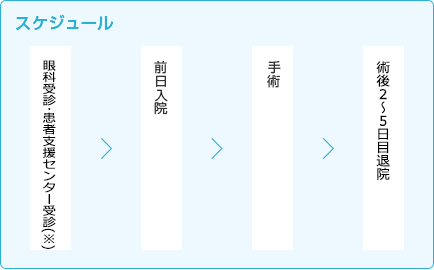
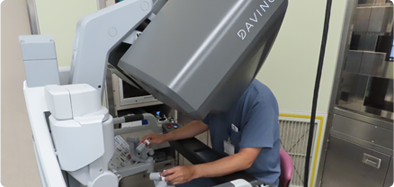
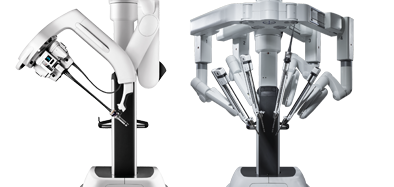
※手術中に眼圧が上がることがあるので、眼病のチェックをします。出血が多い時に備えて、念のためご自分の血液を貯めておく処置です。
- 概要
- 2016年4月から健康保険が適用された定位放射線治療(SBRT)を行っています。「サイバーナイフ」は、ロボットアームにX線照射装置を組み合わせた⾼精度の放射線治療装置です。最⼤で1200⽅向から照射できるロボットアームは、複雑な前⽴腺の形にもミリ単位以上の精度で対応が可能です。前立腺の位置は腸のガスや膀胱に溜まった尿などにより動くことが知られています。治療に先立って前立腺の中に照射の目印となる金マーカーを留置(1泊2日の入院)することで、正確な前立腺の位置を把握しながら照射することが可能です。
- メリット
- 従来の強度変調照射部分(IMRT)は37〜39回の照射が必要で通院治療が7〜8週間続くことが大きな負担でした。ピンポイント照射が可能なサイバーナイフによるSBRTは、前立腺に十分な量の放射線を集中させ、周囲への影響を最小限にすることができます。前立腺がんの場合、1〜2日おきに5回の外来通院での照射、2週間で治療は終わります。照射中は痛みもなく、身体への負担が少ないのも特徴です。
- 「spaceOARシステム」
- 放射線による直腸後遺症(下血、肛門痛)を予防する目的で、前立腺と直腸の間にハイドロゲルを注入する方法で、東部病院では2018年3月から実施しています。ハイドロゲルは体内に注入すると固まり、数ヶ月後に吸収されます。ハイドロゲルにより前立腺と直腸の間にスペースができるため、直腸にかかる放射線が大幅に低減されます。注入は、金マーカー留置のときに同時に行うので、特別な負担はありません。

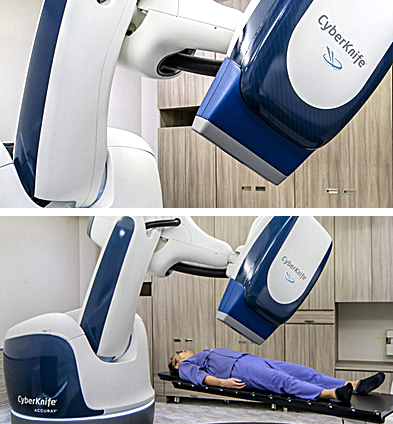
- 概要
- 微弱な放射線を出す⼩さな線源を⾝体の中(前⽴腺の内部)に挿⼊し、体内から放射線を照射する治療法です。線源を埋め込むときはコンピューターにより、治療効果が⾼くほかの臓器への影響が少ない位置を選びます。前⽴腺の中に集中して放射線を照射できることで⼤きな治療効果が期待できます。
- メリット
- 挿⼊された線源から出る放射線を前⽴腺内に集中的に照射するため、尿失禁や勃起障害などの合併症が少なく、⼿術も3泊4⽇という短期間の⼊院でできます。副作⽤として排尿障害が起こりますが、多くは半年から1年ほどで改善します。病状により、小線源治療に通院での体外照射や内分泌治療を併用することがあります。詳しくは担当医にご相談ください。
- 「spaceOARシステム」
- 放射線による直腸後遺症(下血、肛門痛)を予防する目的で、前立腺と直腸の間にハイドロゲルを注入する方法で、東部病院では2018年3月から実施しています。ハイドロゲルは体内に注入すると固まり、数ヶ月後に吸収されます。ハイドロゲルにより前立腺と直腸の間にスペースができるため、直腸にかかる放射線が大幅に低減されます。注入は、小線源を留置のときに同時に行うので、特別な負担はありません。

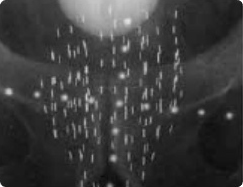
※より効果的な治療(根治性向上)のため小線源治療と体外照射を併用することがあります。併用治療の場合、線源刺入の約1ヶ月経過後に15~20回程度の通院での照射を行います。
- 概要
- アクアビーム(AquaBeam) を用いた アクアブレーション治療は、前立腺肥大症(BPH)の治療に対して行われる低侵襲手術です。手術では、前立腺の大きさ・形に応じて作成した治療計画に沿って、ロボットが高圧のウォータージェットを噴射し、前立腺組織を精密に切除します。切除に要する時間は5-10分程度、手術全体にかかる時間は通常1時間前後です。
- メリット
- 従来からあるレーザーや電気メスで前立腺を切除する手術は、前立腺が大きいと手術時間が長くなり体への負担が大きくなります。アクアブレーションは前立腺の大きさ・形による影響は受けにくく、同等の治療効果であると同時に比較的短い時間で手術を受けることができます。
熱を発する治療では無いことと、失禁や射精に関連する場所へのダメージをロボットの制御により避けることができるため、手術後の尿失禁・射精障害などの後遺症が起こりにくい治療方法です。
「治療効果の高さ」「体への負担の少なさ」「術後後遺症の少なさ」が特徴のアクアブレーション治療は、患者さんのQOL(生活の質)を向上させる治療法として注目されています。

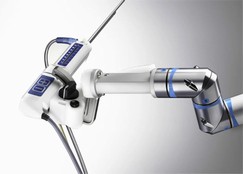
アクアビームを導入しているのは
全国で11施設のみ(2025年2月現在)
治療実績
| 臓器 | 疾患 | 治療 | 2015年度 | 2016年度 | 2017年度 | 2018年度 | 2019年度 | 2020年度 | 2021年度 | 2022年度 | 2023年度 | 2024年度 |
| 前立腺 | 前立腺がん | ロボット支援下 根治的前立腺全摘術 |
71 | 70 | 78 | 103 | 125 | 111 | 106 | 107 | 118 |
116 (Xi87/SP29) |
| 根治的前立腺全摘術 (腹腔鏡下・開放手術) |
0 | 0 | 0 | 0 | 0 | 0 | 0 | 0 | 0 | 0 | ||
| 精巣摘除術 (内分泌治療として) |
5 | 9 | 13 | 11 | 4 | 10 | 1 | 8 | 4 | 1 | ||
| 密封小線源治療 | 72 | 63 | 46 | 34 | 49 | 35 | 35 | 49 | 43 | 30 | ||
| うち外照射併用治療 | 38 | 32 | 21 | 18 | 33 | 25 | 23 | 42 | 36 | 25 | ||
| うち救済小線源治療 | 0 | 0 | 0 | 0 | 0 | 0 | 2 | 7 | 0 | 0 | ||
| 体幹部定位放射線治療 (SBRT) |
0 | 0 | 16 | 31 | 40 | 37 | 28 | 32 | 29 | 37 | ||
| 前立腺針生検 | 331 | 325 | 327 | 363 | 432 | 350 | 331 | 371 | 355 | 344 | ||
| 前立腺肥大症 | アクアビーム(高圧水噴射)※ | 10 | ||||||||||
| HoLEP (レーザー前立腺核出術) |
65 | 50 | 54 | 45 | 45 | 29 | 24 | 51 | 33 | 45 | ||
| TUEB (経尿道的前立腺核出術) |
0 | 0 | 0 | 10 | 11 | 10 | 14 | 0 | 0 | 0 | ||
| TURP (経尿道的前立腺切除術) |
1 | 2 | 2 | 0 | 1 | 6 | 2 | 5 | 5 | 4 | ||
| 開放被膜下摘除術 (恥骨上式、恥骨後式) |
0 | 0 | 0 | 0 | 1 | 0 | 0 | 0 | 1 | 0 |
※2024年2月導入
ダビンチによる前立腺がん手術の費用例
前立腺全摘除術入院7日間(入院期間が月をまたがない場合)
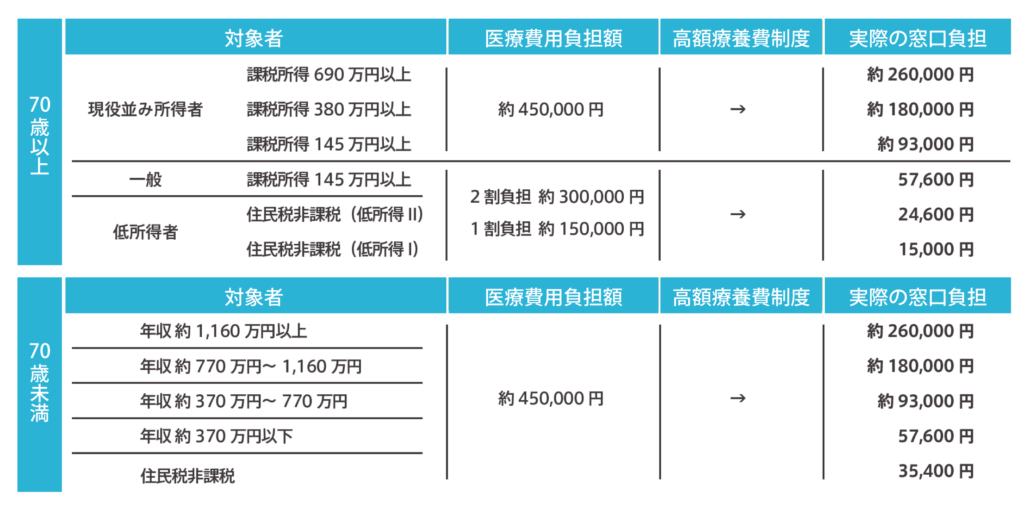
患者さんの年齢や所得に応じて医療費の負担割合は異なりますが、
高額療養費制度を利用すれば、所得に応じた一定の限度額以上の自己負担は軽減されます。
全国共通の制度ですので、同じ条件であれば他の医療機関と自己負担額が大きく異なることはありません。
今回ご紹介した「アクアビーム」「ダビンチ」「サイバーナイフ」「密封小線源治療」も、同制度を利用すれば自己負担額はいずれも同じになります。
よくある質問
- 「ダビンチ」「サイバーナイフ」「密封小線源治療」どの治療が1番良いのですか?
患者さんごとに病状(がんの状態、前立腺肥大の有無)、これまでにかかった病気や手術歴、年齢など様々な条件が異なります。また、仕事や趣味、生活のスタイルなども人それぞれのため、患者さんによって最適な治療は異なります。
東部病院では多くの治療手段を揃えることで、最適な治療を提案しています。 - どこに問い合わせれば良いですか?
代表電話からお問い合わせください。
済生会横浜市東部病院
腎泌尿器センター 泌尿器科
電話:045-576-3000(代表)
平日 9:00〜17:00


















